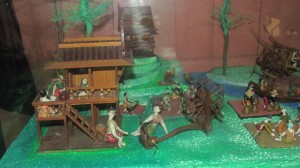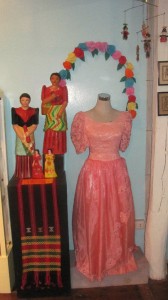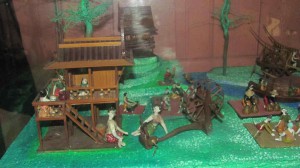By ELLEN TORDESILLAS
 WHERE once there were only cries of anguish and despair, the voices heard from “Balay ni Datu Lubay” these days are expressions of fun and admiration.
WHERE once there were only cries of anguish and despair, the voices heard from “Balay ni Datu Lubay” these days are expressions of fun and admiration.
Balay ni Datu Lubay (House of Datu Lubay) in San Jose, Antique houses Alex de los Santos’ collection of more than 1,000 dolls and figurines, some of them made by potters in the province.
The toy museum is run by the Datu Lubay Center, chaired by de los Santos who also serves as artistic director. Organized in 2008, the center aims to promote culture and arts education among Antiqueños as a tool for empowerment and social change.
It was named in honor of Datu Lubay, one of the 10 Bornean datus who fled tyranny in their homeland and settled in Antique eight centuries ago. Datu Lubay taught the women of Antique how to weave.
De los Santos said the idea of a toy museum came about when his collection of dolls in national costumes of different countries grew large. His first doll was Thai, which he got in Chiang Mai. Almost all countries are now represented in his collection.
 After the dolls came other toys that were souvenir items from family members and friends. Now there are over a thousand items in the two-year-old museum.
After the dolls came other toys that were souvenir items from family members and friends. Now there are over a thousand items in the two-year-old museum.
There are also a number of miniature figurines by Alan Cabalfin, a ceramic artist from Leon, Iloilo, who taught the potters of barrio Bari in the nearby town of Sibalom to make figurines aside from jars and pots.
When De los Santos tells the story of Balay ni Datu Lubay, he goes back to more than 50 years ago, shortly before the second World War.
De los Santos said the structure that is now “Balay ni Datu Lubay” is a remnant of the house of his great grandparents, Felicitas Esguerra and Emiliano de los Santos. The two-story structure was one of the first big houses in the province’s capital town.
Old folks recall that during typhoons, the De los Santos house served as classroom and refugee center.
When the Japanese occupying forces led by a certain Colonel Okumura came to Antique, they sequestered the house and used it as part of their headquarters.
It’s standard practice in war that soldiers had to be provided pleasure. One of the horrors inflicted by the Japanese Army on the countries they invaded was the establishment of “comfort stations,” where women sex slaves were kept for the pleasure of the soldiers.
One of those women forced into the comfort station was Tomasa Salinog, known to her province mates as “Lola Masing.” Inspired by Rosa Henson, the first Filipina to tell the world of her story as a comfort woman for the Japanese Imperial Army, Lola Masing related her own ordeal.
She said she was 14 when the Japanese came to Antique. Her father was killed in front of her by the occupying forces. She remembered being brought to the De los Santos house where she and the other girls were forced as sex slaves by the Japanese soldiers.
After the war, she became a seamstress. She kept the horrors and pain of the war to herself. In 1993, she heard through the radio about a group of lawyers who were helping Filipino comfort women seek justice from the Japanese government. Lola Masing sold a blanket she had made to be able to make the trip to Iloilo to see the lawyers.
She rejected the offer of the Japanese government of financial assistance. She wrote the Japanese government, “I will not accept your money. I need your apology.”
She never got the apology. She passed away on April 6, 2007.
In honor of Lola Masing, De los Santos has marked a portion of Balay ni Datu Lubay as “Center for Culture and Peace.”
The museum has become a popular destination of visitors of San Jose, whose major landmark is the statue of the late Gov. Evelio Javier at the plaza.
Javier was assassinated while monitoring the canvassing of the results of the 1986 snap presidential election between Corazon Aquino and then incumbent president Ferdinand Marcos. His death helped spark the 1986 People Power revolution.
San Jose is the capital of Antique, one of the four provinces on the island of Panay (the other three are Iloilo, Capiz and Aklan) in Western Visayas. The province is the major producer of moscuvado sugar, which is enjoying a revival with more and more people going for healthy food.
Every year, Antique reenacts the landing of the Bornean datus in a festival called “Binirayan,” which means a fluvial parade.
